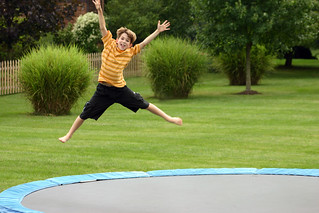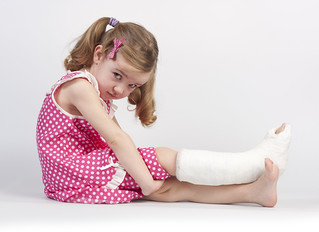Author: Whitney Hollingshead
When I was a little girl, I wanted a trampoline more than anything. My sister and I begged my parents for a trampoline for years. We were both very involved in gymnastics and we wanted to practice our tricks at home. Eventually we gave up on our parents and decided begging Santa was likely to produce better results. In the case of our parents, their apprehension had little to do with the size of our request, and everything to do with our safety.
One particular weekend, my parents left my sister and me in the care of some close family friends. This family had a trampoline and my sister and I were beyond thrilled to be granted some time outside. Our joy was cut short when a mishap on the trampoline resulted in my teeth striking her head. I was immediately rushed to the dentist and my sister received a wound worthy of attention.
While this injury stands out in my mind, even decades later, I am grateful that neither my sister nor I experienced more severe injuries on any trampoline. Trampolines produce a lot of fun for kids, teens, and even adults; however, amidst all of the fun and games, trampolines definitely have a darkside.
 Do you know the history of trampolines? George Nissen patented the modern trampoline in 1945 as a “tumbling device”. Nissen was a competitive gymnast. The trampoline was initially designed as a training tool for gymnasts and acrobats. Nissen also later promoted the trampoline for military aviator training. All of these purposes have one major attribute in common. The trampoline was originally intended to be used by individuals who were skilled. These skilled individuals also had additional training and supervision from other highly skilled individuals.
Do you know the history of trampolines? George Nissen patented the modern trampoline in 1945 as a “tumbling device”. Nissen was a competitive gymnast. The trampoline was initially designed as a training tool for gymnasts and acrobats. Nissen also later promoted the trampoline for military aviator training. All of these purposes have one major attribute in common. The trampoline was originally intended to be used by individuals who were skilled. These skilled individuals also had additional training and supervision from other highly skilled individuals.
 Here are some facts about trampolines that may surprise you:
Here are some facts about trampolines that may surprise you:
Each year approximately 100,000 Americans end up in the emergency room with trampoline related injuries.
Trampolines can cause fractures, spinal injuries, serious head injuries, paralysis, and even death. Children under the age of 5 are especially susceptible to fractures and dislocation injuries.
The American Academy of Pediatrics noted that between one-third to one-half of all injuries still occurred while children were being closely supervised by adults.
The AAP also warns that research does not show that enclosures and padding greatly reduce the number of injuries. Instead these safety measures seem to produce a false sense of security.
Most homeowner’s insurance policies don’t cover trampolines. If your neighbor, or even your own child in some cases, gets injured on the trampoline, you may be in big trouble. Depending on the situation, you could find yourself involved in a lengthy and expensive lawsuit.
Trampolines at home tend to be the most dangerous, but this includes trampolines at any home. If you choose to not purchase a trampoline, make sure you are aware of other situations where your children may come in contact with trampolines.
 Dr. Skedros, an orthopedic surgeon in Utah, is generally not a fan of trampolines. If you decide to use them anyway, he makes the following recommendations:
Dr. Skedros, an orthopedic surgeon in Utah, is generally not a fan of trampolines. If you decide to use them anyway, he makes the following recommendations:
1. Check your homeowner’s insurance policy to see if your policy covers a trampoline. If not, make sure you update your policy to cover the trampoline before you consider purchasing one. If you already own a trampoline and discover your policy does include trampoline coverage, make sure you keep everyone off of the trampoline until your policy is updated.
2. Make sure your trampoline is even with the ground surrounding it AND enclosed by a safety net.
3. NEVER allow more than one person on the trampoline at any time. Make sure this rule is always strictly enforced.
In recent years, many trampoline parks have opened all over the country. These locations are especially inviting for various parties and events. While many trampoline parks post safety information, the suggested restrictions are often not in alignment with the views of physicians and surgeons. If your children visit a trampoline park, make sure that additional safety precautions are taken if you feel like the facility enforced rules are simply not enough.
Trampolines will always be enticing to children. While they do offer the potential of endless hours of recreational fun, make sure you are well educated on the risks as well. Remember, if your gut says that having a trampoline at home is not a good idea, don’t give in to the pleas of your children. Their safety should always outweigh your popularity as a parent. A simple “no” now could potentially spare your child from years of unnecessary pain and discomfort.


















